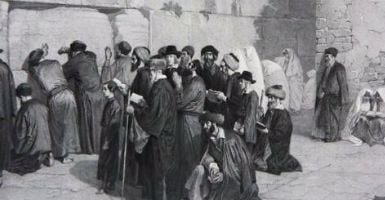Recently, a scandal at Asuta Hospital in Rishon l’Tzion attracted public attention. Genetic testing of a fetus conceived through in vitro fertilization led to the shocking discovery that there was no genetic compatibility between the pregnant woman and the fetus (which, by that time, had already been born). The results were unequivocal; the baby did not belong to her and her husband.
Further tests suggested that another couple had a high chance of compatibility with the fetus and an investigation was opened. Meanwhile, the first woman declared that she would not accept any finding that would separate her from the child, and that she should absolutely be considered its mother. Shortly thereafter, it was determined that there was no genetic connection between the other couple and the fetus, and, therefore, the child would remain in the woman’s custody until the genetic parents are identified.
Before discussing the Halachic aspects of this question, we should point out that incidents like this, despite their rarity, highlight the critical need for rigorous supervision of fertility laboratories to prevent errors. Although many have placed their trust in basic laboratory policies and protocols, as this case illustrates, mistakes can and do happen. In such a sensitive area, even one mistake is one too many.
Let us examine this case from the Halachic perspective:
After a great deal of discussion and a dispute that lasted decades, Poskim of the last generation permitted in-vitro fertilization (IVF). In situations where there is a high chance of a serious or fatal genetic defect that can only be avoided through pre-implantation genetic diagnosis (PGD), IVF is a necessity.[1] However, there remain diverse opinions regarding surrogacy. Is a woman permitted to become pregnant with the sperm of a man who is not her husband? What is the relationship between the child, the biological mother, and the gestational carrier?
This question holds significant practical importance. For instance, whom is the child obligated to honor as the Mitzva of Kibud Em? Who are his maternal relatives (whom he is forbidden to marry)? If the surrogate isn’t Jewish, need he undergo conversion? The questions span the entire breadth of all four sections of the Shulchan Aruch.
The case in Asuta Hospital raises another question. To whom does the child belong? Who will raise it? In regular cases of gestational carriers, these questions are not applicable because the pregnancy is planned and a clear agreement exists between the biological parents and the carrier. In this unfortunate case, the answers to these questions also depend on resolving the issue of who is considered the mother.
We have thoroughly discussed this topic in another essay.[2] This essay will review the subject and add some further discussion.
There are two arguments lying at the heart of this question. On the one hand, the genetic makeup of the child is extremely significant, as it is the only biological connection between a child and its mother (just as it is the only biological connection between a child and its father – as there is certainly no other biological basis for paternity[3]). Therefore, there is a strong reason to think that the egg donor should be considered the Halachic mother.
Additionally, the embryo was created in a laboratory (by fertilizing the egg) before the gestational carrier was involved at all. At that stage, the only individuals involved were the egg and sperm donors. Therefore, the carrier could be perceived as merely hosting the embryo of another woman in her uterus as though she were an incubator, and has no maternal relationship to it at all.
On the other hand, one could consider fetal development (that occurs in the uterus of the gestational carrier) to be more significant. The fetus receives its nourishment via the carrier, and she will ultimately deliver the baby at birth. Therefore, perhaps she shouldn’t be considered a mere incubator, but, on the contrary, from the moment that the embryo was implanted it becomes a part of her body, and the relationship to the egg donor is severed. Since Chaza”l did not clearly attribute greater significance to a hereditary link than a link borne out of development and birth, one could argue that Halacha would consider the carrier to be the child’s mother.
In the absence of sources that discuss this question explicitly, the Poskim attempt to adduce proofs from other cases discussed by Chaza”l and earlier Halachic authorities. The majority of Poskim agree that there are no clear proofs from which to rule conclusively on this matter, and the ultimate decision rests with each Posek according to his judgment. Therefore, some refrain from ruling on this question at all, maintaining that we are no longer of the caliber to rule on such weighty matters as these, particularly as we can only rely on our judgment.
We will now briefly cite some of the sources that the Poskim discuss in the context of these questions:
Shimon and Dina, Rachel and Leah
In Parshas Vayigash the Torah enumerates the sons of Shimon, son of Yaakov Avinu: “And the sons of Shimon: Yemuel, Yamin, Ohad, Yachin, Zohar, and Shaul, son of the Canaanite woman (Bereishis 46:10).
Who was “Shaul, son of the Canaanite woman”? Chaza”l[4] reveal that he was the son born to Shimon and his sister Dina. When Shimon and Levi rescued Dina from Shechem she was too embarrassed to leave the city and made Shimon promise to marry her. Later she bore him a son called Shaul.[5]
Many of the Mefarshim ask how it was permissible for Shimon to marry his sister. Although the sons of Yaakov had the status of “B’nei Noach” who are permitted to marry their paternal sisters, Dina was Shimon’s maternal sister which is forbidden even to a Ben Noach (Sanhedrin 58a)!
One answer is based upon a famous Ma’amar Chaza”l (cited by Rashi, Bereishis 30:21). Chaza”l relate that Leah knew through Ruach haKodesh that Yaakov Avinu would only have 12 sons. When she became pregnant for the seventh time, she realized that if she were to give birth to another son, Rachel would have the chance to bear only one of the Shevatim, fewer than even Bilha or Zilpa. She therefore Davened for Rachel to be spared this shame and her male fetus was switched to a female.
Chaza”l also relate (see Targum Yonasan ibid.) that Rachel conceived a girl at the same time that Leah conceived a boy. In response to Leah’s Tefila that Rachel not be humiliated, the two fetuses were exchanged – Rachel’s female fetus was transferred to Leah and born Dina, and the male fetus conceived in Leah’s womb was transferred to Rachel and born Yosef.
The Maharsha uses this latter Chaza”l to explain a Gemara in Maseches Niddah (31a). The Gemara asserts that if a woman is “Mazra’as” (emits seed) first during intercourse, a male child will be born from the union, but if a man is “Mazria” first, a female child will be born.[6] The source for this is a Posuk in Parshas Vayigash that states: “There are the sons of Leah whom she bore to Yaakov in Padan Aram, and Dina his daughter” (46:15). The male children are dubbed “the sons of Leah” (as they were brought into existence by their mother being Mazria first), but Dina is called “his (Yaakov’s) daughter” (as she came about due to her father being Mazria first).
According to the aforementioned Chaza”l, Dina was originally conceived as a male, not a female. If so, her conception would have been a result of Leah being Mazria first, like all of her brothers. Why then does the Torah refer to her as “his” (Yaakov’s) daughter?
The Maharsha answers his question simply in light of the second Ma’amar Chaza”l that we cited. Leah’s fetus was not transformed from male to female – it was swapped with the female fetus of Rachel. This female fetus would have been the result of Yaakov being Mazria first, thus it is correct to call her “Yaakov’s daughter”.
Several of the Rishonim[7] explain why Shimon was allowed to marry Dina based on the Ma’amar Chaza”l quoted by the Targum Yonasan. If Dina was conceived by Rachel, Rachel was considered to be her mother (i.e., not Leah). Therefore, she was only a paternal sister to Shimon and permitted to him.
In short, Shimon may have been permitted to marry Dina because she was conceived by Rachel, even though she was born to Leah. This seems to clearly demonstrate that maternity is determined by heredity and not gestation!
However, there are several points to consider:
- The Torah consistently describes Yosef as the son of Rachel and Dina as the daughter of Leah.
- The exchange of the fetuses may well have taken place at the end of each of their respective pregnancies. If so, Rachel would have carried Dina throughout almost the entire pregnancy, and this could be why she was considered to be her mother. We cannot prove that a mother who merely provides the genetic material should be considered the mother over another woman who carries the fetus through pregnancy.
- Finally, we can never draw Halachic conclusions from Ma’asei Nisim.
Geirus While Pregnant with Twins (Yevamos 97b)
If a non-Jewish woman is pregnant with twins and undergoes Geirus (conversion) during her pregnancy, her Geirus is also effective for the fetuses. Usually, a person is considered like “a newborn child” following Geirus, and is no longer Halachically related to his biological relatives (thus, if his sister also converts he would be permitted, mid’Oraisa, to marry her). Nevertheless, when a mother pregnant with twins converts, the twins retain their status as siblings, despite the conversion (Yevamos 97b).
Some say that this proves that maternity must be established at the moment of birth (or perhaps during pregnancy). Although the twins undergo conversion during pregnancy, since their gestation occurs in the same woman and she gives birth to them, they are considered to share a mother and thus are siblings. Were maternity to be only established by the egg “donation” or at the moment of conception, the subsequent conversion would have disrupted that relationship and the twins would be considered unrelated.
This conclusion can be challenged in two ways. Firstly, Rashi’s opinion (in Yevamos 98a) is that the law that a convert is considered to be like a newborn child does not apply to fetuses. Therefore, twin fetuses who undergo conversion are certainly still considered to be siblings. Secondly, even if maternity is generally established through heredity, that doesn’t necessarily mean that it is solely based upon the donation of genetic material. In a normal pregnancy, the same mother provides the genetic material and is the gestational host. Therefore, even if conversion disrupts the original relationship of the fetuses to the mother (and each other), perhaps it is reestablished by gestation and/or delivery. [8]
The First Forty Days – Maya b’Alma (Yevamos 69b)
The Gemara (Yevamos 69b) asserts that an embryo is deemed to be “Maya b’Alma” (mere “water”) during the first forty days following conception and is not considered to have independent status as a “Nefesh”. Some Acharonim contend that even those who hold that a fetus usually requires its own Geirus[9] would agree that it is not required if the conversion occurred during this period.
Implantation of the egg in the surrogate takes place within forty days of fertilization. Therefore, it could be argued that the surrogate should certainly be considered the true mother as the fetus is only established as a Nefesh after implantation in her uterus.
However, this argument can also be refuted. Although during the stage of “Maya b’Alma” the embryo may not have the status of an independent being or Nefesh, it has the potential to develop into a fetus and then a child. This potential and its genetic traits were bestowed by the woman whose egg was fertilized; therefore, she can be regarded as its true mother.
The Three Shutfim (Nidah 31a)
The Rabbis taught: There are three partners in [the creation of] man – Hashem, his father, and his mother. The father provides the “white” from which the bones, sinews, nails, brain, and whites of the eyes develop. The mother provides the “red” from which the skin, flesh, hair, and pupils arise. Hashem imparts the spirit and soul, luster of the face, sight, hearing, power of speech, ability to walk, intuition, and understanding.
This Gemara clearly states that a person’s fundamental connection with his parents (“the partners who created him”) is through the biological and genetic properties they bestowed upon him. A surrogate mother, by contrast, contributes none of these properties. The fact that gestation occurs in her uterus is immaterial. The properties bestowed by a father always develop inside the uterus of the mother and are nevertheless attributed by the Gemara to him. The same applies to the properties bestowed by the genetic mother; though they develop within the surrogate, they are still attributed to her.
Nevertheless, it is generally difficult to draw Halachic conclusions from Divrei Agada, so this cannot be considered definitive proof.
It is difficult to come to a conclusion in this matter – it is a matter of great dispute among the Poskim. See the footnote for additional sources that discuss the topic[10].
In conclusion, there are three opinions:
- Maternity is determined by heredity, and the egg donor is the Halachic mother.
- Maternity is determined by gestation, and the gestational carrier is the Halachic mother.
- It is impossible to determine which one is the mother. Therefore, both women must be considered mothers.
It is important to note, that we have only discussed the question of maternity in gestational carriage, but there are a number of other important questions to consider as well:
- Is it permissible to serve as a gestational carrier?
- May a single or divorced (i.e. unmarried) woman serve as a gestational carrier?
- May a married woman do so?
- May one use a non-Jewish gestational carrier? Is it preferred to use a Jewish or non-Jewish gestational carrier?
These questions have important Halachic ramifications, and practical guidance in actual scenarios should be sought from Gedolei haPoskim.
[1] See the essay on Pekudei 5779.
[2] See the essay on Parshas Vayigash 5781.
[3] The majority of the Poskim maintain that the act of intercourse with the mother is not the basis for considering somebody to be the father.
[4] Bereishis Rabbah, Vayishlach 80:11
[5] There are other sources in Chaza”l that assert that Shaul was actually Zimri ben Salu.
[6] A man being “Mazria” refers to ejaculation. It is unclear what physiologic event Chaza”l were referring to in the female.
[7] The Moshav Zekeinim miBa’alei haTosfos and Tosfos haShalem Al haTorah, Bereishis 46, in the name of the Riva.
[8] [Editor’s note: Perhaps maternity is established through both egg donation and/or gestation. The Gemara’s ruling that twins are considered siblings even after in utero conversion does not conclusively prove that maternity is determined exclusively by gestation.]
[9] The Gemara in Yevamos (78a) explains that according to those who hold “Ubar Lav Yerech Imo” – a fetus is not considered to be a “limb” of its mother (i.e. it is an independent being) – it would require its own independent Geirus after birth. (However, the mother’s Tevila would be considered effective for the fetus as her body is not considered to be a Chatzitza.)
[10] Tzitz Eliezer (15:45, 19:40, 20:49 & 22:55), Nishmas Avraham (4, E.H. 2 in the name of Rav Shlomo Zalman Auerbach zt”l and Rav Elyashiv zt”l). See also Yeshurun 21, p535, R’ Avraham Sherman, also quoting Rav Elyashiv zt”l as well as Rav Avigdor Nebenzahl Shlit”a. Rav Zalman Nechemia Goldberg Shlit”a has two essays on this topic; the first published in Techumin, 5, p248, the second in Asya 65-66, p45.















Add comment